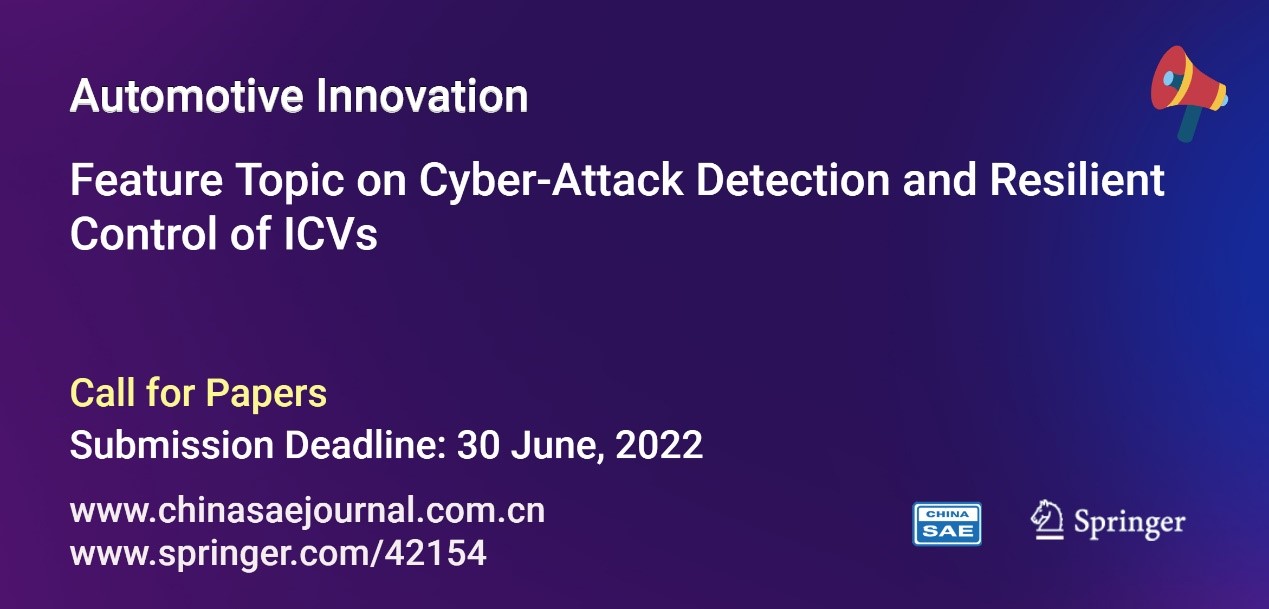

|
The journal Automotive Innovation is sponsored by China SAE, published through Springer, distributed around the world, and reflects the top-level research and technical advance of automotive engineering. Automotive Innovation newsletter in May includes the following contents: 1. Article Recommendation——Four papers from Feature Topic on Advanced Battery Management for Electric Vehicles 2. China SAE News: · ISC 2022 registration starts |

   
|
Non-invasive Characteristic Curve Analysis of Lithium-ion Batteries Enabling Degradation Analysis and Data-Driven Model Construction: A Review Rui Cao, Hanchao Cheng, Xuefeng Jia, Xinlei Gao, Zhengjie Zhang, Mingyue Wang, Shen Li, Cheng Zhang, Bin Ma, Xinhua Liu & Shichun Yang |
||
| Power battery technology is essential to ensuring the overall performance and safety of electric vehicles. Non-invasive characteristic curve analysis (CCA) for lithium-ion batteries is of particular importance. CCA can provide characteristic data for further applications such as state estimation and thermal runaway warning without disassembling the batteries. This paper summarizes the characteristic curves consisting of incremental curve analysis, differential voltage analysis, and differential thermal voltammetry from the perspectives of exploring the aging mechanism of batteries and constructing the data-driven model. The process of quantitative analysis of battery aging mechanism is presented and the steps of constructing data-driven models are induced. Moreover, the recent progress and application of the main features and methodologies are discussed. Finally, the applicability of battery CCA is discussed by converting non-quantifiable battery information into transportable data covering macrostate and micro-reaction information. Combined with the cloud-based battery management platform, the above-mentioned battery characteristic curves could be used as a valuable dataset to upgrade the next-generation battery management system design. | |||
|
Keywords: Lithium-ion · Degradation analysis · Non-invasive characteristic · Data-driven model Cao, R., Cheng, H., Jia, X. et al.: Non-invasive characteristic curve analysis of lithium-ion batteries enabling degradation analysis and data-driven model construction: a review. Automot. Innov. 5(2), 146–163 (2022) |
|||
| Full Paper Reading>> | |||
   
|
Internal Short Circuit Detection for Parallel-Connected Battery Cells Using Convolutional Neural Network Niankai Yang, Ziyou Song, Mohammad Reza Amini & Heath Hofmann |
||
| Reliable and timely detection of an internal short circuit (ISC) in lithium-ion batteries is important to ensure safe and efficient operation. This paper investigates ISC detection of parallel-connected battery cells by considering cell non-uniformity and sensor limitation (i.e., no independent current sensors for individual cells in a parallel string). To characterize ISC-related signatures in battery string responses, an electro-thermal model of parallel-connected battery cells is first established that explicitly captures ISC. By analyzing the data generated from the electro-thermal model, the distribution of surface temperature among individual cells within the battery string is identified as an indicator for ISC detection under the constraints of sensor limitations. A convolutional neural network (CNN) is then designed to estimate the ISC resistance by using the cell surface temperature and the total capacity of the string as inputs. Based on the estimated ISC resistance from CNN, the strings are classified as faulty or non-faulty to guide the examination or replacement of the battery. The algorithm is evaluated in the presence of signal noises in terms of accuracy, false alarm rate, and missed detection rate, verifying the effectiveness and robustness of the proposed approach. | |||
|
Keywords: Internal short circuit · Parallel-connected battery cells · Convolutional neural network · Cell temperature distribution
Yang, N., Song, Z., Amini, M.R. et al.: Internal short circuit detection for parallel-connected battery cells using Convolutional Neural Network. Automot. Innov. 5(2), 107–120 (2022) |
|||
| Full Paper Reading>> | |||
   
|
Data-Based Interpretable Modeling for Property Forecasting and Sensitivity Analysis of Li-ion Battery Electrode Kailong Liu, Qiao Peng, Kang Li & Tao Chen |
||
| Lithium-ion batteries have become one of the most promising technologies for speeding up clean automotive applications, where electrode plays a pivotal role in determining battery performance. Due to the strongly-coupled and highly complex processes to produce battery electrode, it is imperative to develop an effective solution that can predict the properties of battery electrode and perform reliable sensitivity analysis on the key features and parameters during the production process. This paper proposes a novel tree boosting model-based framework to analyze and predict how the battery electrode properties vary with respect to parameters during the early production stage. Three data-based interpretable models including AdaBoost, LPBoost, and TotalBoost are presented and compared. Four key parameters including three slurry feature variables and one coating process parameter are analyzed to quantify their effects on both mass loading and porosity of battery electrode. The results demonstrate that the proposed tree model-based framework is capable of providing efficient quantitative analysis on the importance and correlation of the related parameters and producing satisfying early-stage prediction of battery electrode properties. These can benefit a deep understanding of battery electrodes and facilitate to optimizing battery electrode design for automotive applications. | |||
|
Keywords: Li-ion batteries · Battery electrode · Battery modeling · Data analysis Liu, K., Peng, Q., Li, K. et al.: Data-based interpretable modeling for property forecasting and sensitivity analysis of Li-ion battery electrode. Automot. Innov. 5(2), 121–133 (2022) |
|||
| Full Paper Reading>> | |||
   
|
An Enhanced Data-Driven Model for Lithium-Ion Battery State-of-Health Estimation with Optimized Features and Prior Knowledge Huanyang Huang, Jinhao Meng, Yuhong Wang, Lei Cai, Jichang Peng, Ji Wu, Qian Xiao, Tianqi Liu & Remus Teodorescu |
||
| In the long-term prediction of battery degradation, the data-driven method has great potential with historical data recorded by the battery management system. This paper proposes an enhanced data-driven model for Lithium-ion (Li-ion) battery state of health (SOH) estimation with a superior modeling procedure and optimized features. The Gaussian process regression (GPR) method is adopted to establish the data-driven estimator, which enables Li-ion battery SOH estimation with the uncertainty level. A novel kernel function, with the prior knowledge of Li-ion battery degradation, is then introduced to improve the modeling capability of the GPR. As for the features, a two-stage processing structure is proposed to find a suitable partial charging voltage profile with high efficiency. In the first stage, an optimal partial charging voltage is selected by the grid search; while in the second stage, the principal component analysis is conducted to increase both estimation accuracy and computing efficiency. Advantages of the proposed method are validated on two datasets from different Li-ion batteries: Compared with other methods, the proposed method can achieve the same accuracy level in the Oxford dataset; while in Maryland dataset, the mean absolute error, the root-mean-squared error, and the maximum error are at least improved by 16.36%, 32.43%, and 45.46%, respectively. | |||
|
Keywords: Li-ion battery · State of health · Gaussian process regression · Kernel function · Feature optimization Huang, H., Meng, J., Wang, Y. et al.: An enhanced data-driven model for lithium-ion battery state-of-health estimation with optimized features and prior knowledge. Automot. Innov. 5(2), 134–145 (2022) |
|||
| Full Paper Reading>> | |||

| ISC 2022 registration starts | |||
 China SAE and FISITA are delighted to confirm that the FISITA Intelligent Safety Conference 2022 (ISC 2022) will take place 30-31 August 2022, in Beijing, China, with physical and online participation available to registered participants. ISC 2022 will again see an international speaker line up considering some of the most important topics within the safety of future mobility arena, including SOTIF, Cybersecurity, Human Factors, and Smart Safety Protection. The registration for ISC 2022 has started, and we look forward to your participation. Registration: http://meeting.sae-china.org/ISC2022/ Submission website: www.fisita.com/isc |
|||
| Call for Papers: Feature Topic on Cyber-Attack Detection and Resilient Control of ICVs | |||
 Guest Editors: · Prof. Hui Zhang, Beihang University, huizhang285@gmail.com · Prof. Manjiang Hu, Hunan University, manjiang_h@hnu.edu.cn · Dr. Anh-Tu Nguyen, Université Polytechnique Hauts-de-France, nguyen.trananhtu@gmail.com · Prof. Yunpeng Wang, Beihang University, ypwang@buaa.edu.cn · Prof. Yang Shi, University of Victoria, yshi@uvic.ca Topics: · New security mechanisms of V2X · Modeling of cyber attacks · Model-based and data-based efficient attack detection methods · Attack resilient control approaches · Attack mitigation algorithms Submission deadline: June 30, 2022 Submit at: www.springer.com/42154 To download call for paper, please click here. |
|||
| WNEVC 2022 registration starts | |||
 The 4th World New Energy Vehicle Congress (WNEVC 2022) will be held on Aug. 25-28, 2022 at Haikou. WNEVC 2022 will continue to share insights, discuss cutting-edge trends, and build a high-end international exchange platform in the field of global new energy vehicles. There will be 4 main forums, 10 special forums, 9 technical sessions, 1 high-level closed-door meeting, and over 10,000 square meters of the technical exhibition area. The registration has started, please click here for further information. |
|||

|
Automotive Innovation Sponsored by China SAE and published globally via Springer Nature, Automotive Innovation aims to be a world-class journal that provides abundant sources of innovative findings for automotive engineers and scientists. The journal is published quarterly, ensuring high-quality papers satisfying international standards. With the editorial board consisting of world-renowned experts, it has attracted readers from 72 countries and regions. The highest download of a single article wins more than 21,000. The journal is indexed in Ei Compendex, ESCI, and Scopus. The journal provides a forum for the research of principles, methodologies, designs, theoretical background, and cutting-edge technologies in connection with the development of vehicle and mobility. The main topics cover: energy-saving, electrification, intelligent and connected, safety, and emerging vehicle technologies. Editors-in-Chief Jun Li, Academician of CAE, President of China SAE, Professor of Tsinghua University Frank Zhao, Honorary Lifetime President of FISITA, Director of Tsinghua Automotive Strategy Research Institute, Professor of Tsinghua University Honorary and Founding Executive Editor-in-Chief Prof. Fangwu (Mike) Ma Executive Associate Editor-in-Chief Prof. Xinjie Zhang, Professor of Jilin University |
||||
|
Paper submission and browse www.ChinaSAEJournal.com.cn www.springer.com/42154 Contacts: Ms. Lily Lu Tel: +86-10-50950101 Email: jai@sae-china.org 
|

|
|||
|
Sponsored by |
Published by
|
|||